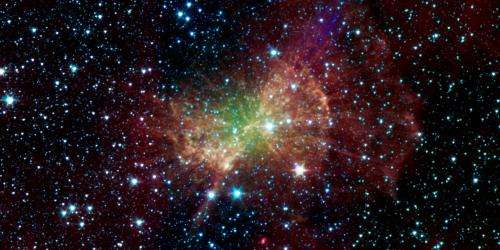A cosmic inkblot test

(PhysOrg.com) -- If this were an inkblot test, you might see a bow tie or a butterfly depending on your personality. An astronomer would likely see the remains of a dying star scattered about space -- precisely what this is. NASA's Spitzer Space Telescope captured this infrared view of what's called a planetary nebula, which is a cloud of material expelled by a burnt out star, called a white dwarf. This object is named the Dumbbell nebula after its resemblance to the exercise equipment in visible-light views.
"It is interesting how different Spitzer's view of the Dumbbell looks compared to optical images," said Dr. Joseph Hora, the principal investigator of the observations from the Harvard Smithsonian Center for Astrophysics, Cambridge, Mass.
In Spitzer's infrared view, the diffuse green glow, which is brightest near the center, is probably from hot gas atoms being heated by the ultraviolet light from the central white dwarf. A collection of clumps fill the central part of the nebula, and red-colored radial spokes extend well beyond. Astronomers think these features represent molecules of hydrogen gas, mixed with traces of heavier elements. Despite being broken apart by the ultraviolet light from the central white dwarf, much of this molecular material may survive intact and mix back into interstellar gas clouds, helping to fuel the next generation of stars.
Provided by JPL/NASA

















